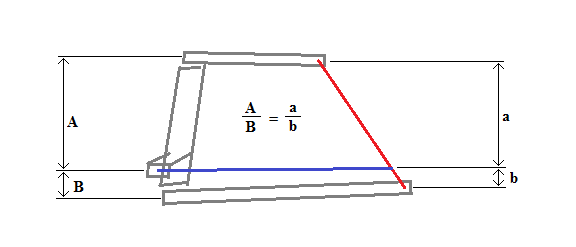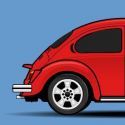benzine
Part of things
 
Posts: 344
Club RR Member Number: 87
|
|
Oct 10, 2011 20:59:55 GMT
|
|
Anyone done this? Is it a case of welding some beefy brackets to the crossmember and trying to replicate the same angles the track rods were at when a steering box was being used? Rack length, column-to-rack connection would need sorting out too. Is it even legal? If so is it a job best left to pros?
cheers!
|
| |
|
|
|
|
|
|
|
|
|
|
I'm doing one on my standard 10, If you look at the original system it should give you most of the lengths you need, the track rods need to be almost the same length as the bottom arm, that should deal with bump steer. This will dictate the length of rack, most manual racks can be cut down I used a escort mk2 item as the splines on input are the same as currently on car and the track rod ends are the same thread. I had to cut the shaft down by 60mm and the body by 55mm (the difference limits the travel of rack to stop my wheels hitting the inner wing)
The rack then needs to be mounted so the track rod lies at same angle as bottom arm. Most of time this layout is already there so it is just a case of finding/modifying a rack to fit.
What i'll be doing with my car to hook it up is I got 2 group 2 Uj's and a 400mm splined both ends connector rod thing (i'll shorten this), shorten the column shaft then join it all together.
Then you need some beefy brackets and a sparky gun.
|
| |
Last Edit: Oct 12, 2011 14:37:07 GMT by damien4884
1977 datsun 810 180b estate |
|
|
|
|
Oct 11, 2011 15:43:07 GMT
|
|
FWIW, with the engine fitted/fluids added/driver added, the track rods should be as close to horizontal as possible. This gives the least possible chance of bump-steer occuring, same as what damien said, they should ideally be the same length as the lower arms
After that, it's all specific to each model of car you're transplating to/from. But if you have a whole donor car to play with, you can measure as much as you like, and see exactly for yourself how beefy the mounts need to be. This is the downside of just getting a steering rack off fleabay - you have nothing to compare it to!
As long as you can weld PROPERLY (none of this "it looks curse word, but it's strong", it's curse word, deal with it) have enough steel to make the mounts up nice and strong, and can get the column to match upto the rack, then that's 99% of the hard work done!
|
| |

You're like a crazy backyard genius! |
|
|
|
|
Oct 11, 2011 17:50:24 GMT
|
|
planning this on my p4 over the winter.....thanks for the tips
|
| |
loving the dub
|
|
RobinJI
Posted a lot
   "Driven by the irony that only being shackled to the road could ever I be free"
"Driven by the irony that only being shackled to the road could ever I be free"
Posts: 2,995
|
|
Oct 11, 2011 18:42:43 GMT
|
FWIW, with the engine fitted/fluids added/driver added, the track rods should be as close to horizontal as possible. This gives the least possible chance of bump-steer occuring, same as what damien said, they should ideally be the same length as the lower arms This isn't necessarily true, depending on the suspension set-up. For instance a horizontal tie rod will give bump steer if fitted to a MacPherson strut with an angled lower arm. If you let us know what set-up's on there at the moment, in terms of suspension and steering, we should be able to let you know the best place to position the various bits. |
| |
|
|
Dez
Club Retro Rides Member
And I won't sit down. And I won't shut up. And most of all I will not grow up.
Posts: 11,790
Club RR Member Number: 34
|
|
Oct 11, 2011 18:51:22 GMT
|
|
^^ agreed^^
avoiding suspension inputs effecting your steering is about parallellograms, not outright level-ness.
what damien says about putting the trackrods at the same angle as your bottom arms will give a far better driving setup.
bumpsteer is caused by triangles of forces which happens because most steering setups are compromises and have components that move in a different arc to the suspension, leaving the forces inflicted by wheel movement with nowhere to go other than feeding back through the steering system.
front to rear placement of the rack is also pretty critical in avioding bumpsteer- too far back or forward and youll get the same thing happening.
|
| |
Last Edit: Oct 11, 2011 18:52:58 GMT by Dez
|
|
benzine
Part of things
 
Posts: 344
Club RR Member Number: 87
|
|
|
|
Thanks everyone for the info! If you let us know what set-up's on there at the moment, in terms of suspension and steering, we should be able to let you know the best place to position the various bits. This is the front suspension:  I'll have to find a pic/diagram of the steering box and linkages the front suspension when it was on the car... |
| |
|
|
|
|
|
Oct 12, 2011 16:24:47 GMT
|
|
You don't HAVE to achieve the desired geometry purely by rack position - it is possible to modify the hub to relocate the steering knuckle as well if you are reasonably competent at fabrication - e.g. if your steering arms are angled upwards when the lower wishbone is level, cutting the knuckles off and re-positioning them further down the hub will have the same effect as moving the rack upwards.
You may also find that you need to lengthen or shorten the steering knuckles to get the desired amount of steering lock per turn of the wheel - you can shorten simply by redrilling if the rod ends are not tapered fit. This obviously effects the weight of the steering as well - shorter knuckles (moving the point the rod end bolts in closer to the hub centre line) will give more lock per turn, but result in heavier steering.
|
| |
|
|
RobinJI
Posted a lot
   "Driven by the irony that only being shackled to the road could ever I be free"
"Driven by the irony that only being shackled to the road could ever I be free"
Posts: 2,995
|
|
Oct 12, 2011 18:12:37 GMT
|
Ok cool, well that looks like the steering arms are pretty low on the hubs, are they in fact low enough that the track rod end's ball joint is at the same height as the pivot of the lower ball joint? If it is, then that's nice and easy, you just want the racks inner pivots to also be inline with the inner pivots of the lower arms. If not, then you want the arms to be something like this:  |
| |
|
|
|
|
|
Oct 12, 2011 18:31:18 GMT
|
I did this earlier but only just got round to posting it.  I did mine so when pointing straight ahead the rack is straight when viewed from above (red line). Thats the forward/back position sorted (this could be wrong but its what I did, most cars I looked at were like it so it must be alright). Then you'll need the track rods to run parallel to the bottom arms (like robinJI's illustration above), you'll need to know what track rods you are using for this as the height varies a bit. That should give the height the rack needs to be mounted at. Once you have worked all of that out you can then work out the length of the rack, the inner joints should be aligned over the yellow lines going through top and bottom inner arm pivots. Few more things now the kids are sleeping. Theres a aston martin powered p1800 that uses a tr4 steering rack. I don't know much about it but could be a good place to start. Shortening a rack is quite easy if you know someone with a lathe, extending track rods is straight forward too so most issues can be overcome fairly easily. Another thing i forgot to mention although you might be alright looking a the pictures, you'll need a bearing to support the steering column where it comes through the bulkhead if you use UJ's, the one on the standard has a bearing under the cowl and the other end was only supported by the steering box as it was straight through with a little rubber coupling. |
| |
Last Edit: Oct 12, 2011 18:45:24 GMT by damien4884
1977 datsun 810 180b estate |
|
|
|
|
|
|
Theres a aston martin powered p1800 that uses a tr4 steering rack. I don't know much about it but could be a good place to start. Another option - F2 stock cars use Ford hubs, but usually have a Moggy 1000 rack with rack extenders to widen the track width - no idea why, but it does mean moggy 1000 steering bits including the parts to make a custom column to suit are available off the shelf from stock car suppliers - example: randallmotorsport.ssl-01.com/index.php?cPath=68&osCsid=1pnkniri2jiok4mhtog9vfmi45 |
| |
|
|











